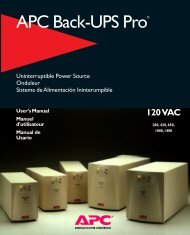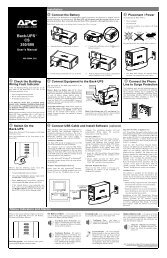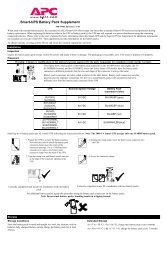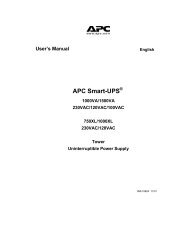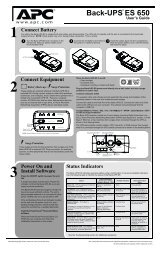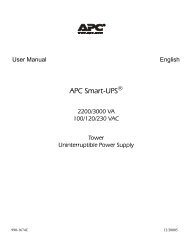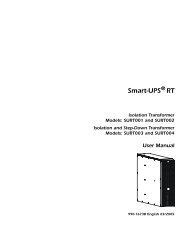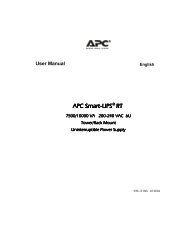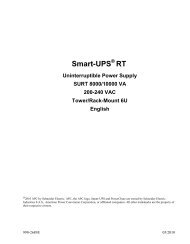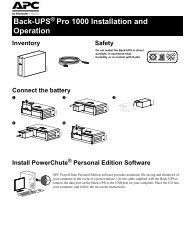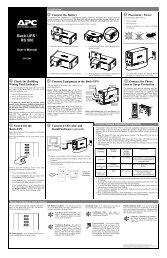APC Smart-UPS 5000 User Manual - ExcessUPS
APC Smart-UPS 5000 User Manual - ExcessUPS
APC Smart-UPS 5000 User Manual - ExcessUPS
Create successful ePaper yourself
Turn your PDF publications into a flip-book with our unique Google optimized e-Paper software.
Troubleshooting<br />
Use the chart below to solve minor <strong>UPS</strong> installation problems. Contact <strong>APC</strong> Technical Support Staff for assistance with<br />
complex <strong>UPS</strong> problems. See <strong>APC</strong> Contact Information, page 15, for a location near you.<br />
Problem and Possible Cause Solution<br />
<strong>UPS</strong> will not turn on.<br />
•=ON button not pushed. Press the ON button once to power the <strong>UPS</strong> and the load.<br />
•=<strong>UPS</strong> not connected to AC power supply. Check that the power cable from the <strong>UPS</strong> to the power<br />
supply is securely connected at both ends.<br />
•=<strong>UPS</strong> input circuit breaker tripped. Reduce the load on the <strong>UPS</strong> by unplugging equipment and<br />
reset the circuit breaker (on back of <strong>UPS</strong>) by pressing the<br />
plunger back in.<br />
•=Very low or no utility voltage. Check the AC power supply to the <strong>UPS</strong> with a table lamp.<br />
If very dim, have the utility voltage checked.<br />
•=Battery not connected properly. Confirm the battery connections.<br />
<strong>UPS</strong> will not turn off.<br />
•=Internal <strong>UPS</strong> fault. Do not attempt to use the <strong>UPS</strong>. Unplug the <strong>UPS</strong> and have it<br />
serviced immediately.<br />
<strong>UPS</strong> operates on-battery although normal line voltage exists.<br />
•=<strong>UPS</strong>’s input circuit breaker tripped. Reduce the load on the <strong>UPS</strong> by unplugging equipment and<br />
reset the circuit breaker (on back of <strong>UPS</strong>) by pressing the<br />
•=Very high, low, or distorted line voltage.<br />
Inexpensive fuel powered generators can distort<br />
the voltage.<br />
990-7032A, Revision 3 7/01 14<br />
plunger back in.<br />
Move the <strong>UPS</strong> to a different outlet on a different circuit.<br />
Test the input voltage with the utility voltage display. If<br />
acceptable to the load, reduce the <strong>UPS</strong>’s sensitivity. Refer<br />
to Voltage Sensitivity, page 6, for procedures.<br />
<strong>UPS</strong> beeps occasionally.<br />
•=Normal <strong>UPS</strong> operation. None. The <strong>UPS</strong> is protecting the load.<br />
<strong>UPS</strong> does not provide expected backup time.<br />
•=The <strong>UPS</strong>’s battery is weak due to recent outage or<br />
is near the end of its service life.<br />
Charge the battery. Batteries require recharging after<br />
extended outages. Also, they wear faster when put into<br />
service often or when operated at elevated temperatures.<br />
If the battery is near the end of its service life, consider<br />
replacing the battery even if the replace battery indicator is<br />
not yet lit.<br />
•=The <strong>UPS</strong> is overloaded. Check the <strong>UPS</strong>’s load display. Unplug less needed<br />
equipment, such as printers.<br />
Front panel indicators flash sequentially.<br />
•=The <strong>UPS</strong> has been shut down by remote control. None. The <strong>UPS</strong> will restart automatically when utility<br />
power returns.<br />
All indicators are lit and <strong>UPS</strong> emits a constant beeping.<br />
•=Internal <strong>UPS</strong> fault. Do not attempt to use the <strong>UPS</strong>. Turn the <strong>UPS</strong> off and have<br />
it serviced immediately.<br />
All indicators are off and <strong>UPS</strong> is plugged into wall outlet.<br />
•=The <strong>UPS</strong> is shut down and the battery is<br />
None. The <strong>UPS</strong> will return to normal operation when the<br />
discharged from an extended outage.<br />
The replace battery light is lit.<br />
power is restored and the battery has a sufficient charge.<br />
•=Weak batteries. Do another self test to see if it clears.<br />
•=Replacement batteries not connected properly. Confirm the battery connections.



